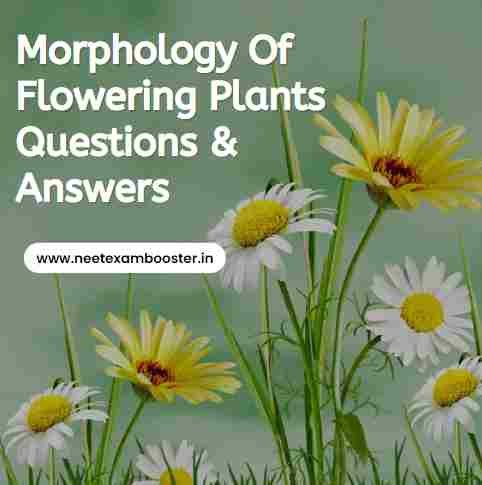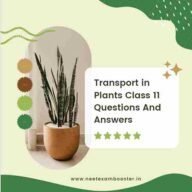Morphology Of Flowering Plants Class 11
Morphology Of Flowering Plants Class 11:- The huge wide range of the structure in the higher plants will never fail to surprise the human.The plants will show their different morphology and their anatomy.Here we are going to learn about the morphology i.e the external appearance such as presence of roots,stems,leaves,flowers and fruits.
Morphology Of Flowering Plants Class 11 Questions & Answers
Q.1. How is oxygen obtained by the roots of the plants growing in swamps and marshes?
A.1. The plants growing in swamps and marshes become negatively geotropic by growing roots vertically upwards for respiration.
Q.2. For the purpose of photosynthesis name some modifications of plant parts.
A.2. Stem gets modified into a leaf_like appearance to carry out photosynthesis. In plants like Tinospora and Trapa, the roots grow out from soil and develop chlorophyll to performing photosynthesis.
Q.3. What are the edible parts of onion and ginger?
A.3. The modified stem of ginger is edible. All the food material is stored here. The fleshy leaves of onion are the edible.
Q.4. Distinguish pinnately compound leaf and palmately compound leaf?
A.4.
| Pinnately Compound Leaf | Palmately Compound Leaf |
| On a common axis called the rachis, the midrib of the leaves is present | Petioles have leaflets attached to their tip. |

Q.5. With suitable examples describe the different types of phyllotaxy.
A.5. Phyllotaxy is the pattern in which the leaves are arranged on the stem . These are of three types:
- Alternate Phyllotaxy- leaf comes from the each node in an alternate manner. For eg. sunflower, China rose.
- Opposite Phyllotaxy- The leaves lies opposite to each other arising at each node. For eg., Calotropis
- Whorled Phyllotaxy– At each node more than two leaves arise to form a whorl. For eg., Alstonia
Morphology Of Flowering Plants Class 11 Quiz
Q.6. Explain modifications of the stem. Give some examples for the same.
A.6. Modifications of the stem:
- Stem Tendrils- They are branched with scaly leaves. Eg., Passiflora, Antogonon
- Stem Thorns- They are sharp needle-like structures that they formed to reduce transpiration and also works as a defence. For eg., Citrus, Pomegranate
- Phylloclades- They are green, flattened, succulent, leaf-shaped structures that they perform photosynthesis. They possess indefinite growth. For eg., Opuntia, Euphorbia soyleana.
- Cladodes- They are green, photosynthetic with limited growth. The leaves are modified into spines or reduced to scales. For eg., Ruscus, Asparagus
Q.7. Other than the radicle which two roots develop from different parts of the angiosperm plant ?
- From lower nodes of the stem of tree prop roots of the banyan tree develop.
- From lower nodes of the stem and penetrate the soil stilt roots in sugarcane- Arise. Both the roots are meant to support provider.
Q.8 Distinguish between the roots of aquatic plants and terrestrial plants.
A.8.
| Roots of aquatic plants | Roots of terrestrial plants |
| The roots may or may not be present here. | Roots are present and well-developed. |
| Vascular bundles are not well developed or poorly developed | The Vascular bundles are well developed. |
| Modified to perform various works such as photosynthesis, food storage and gaseous exchange. | Perform various works such as anchoring the plant firmly in the soil, and absorbing nutrients from the soil. |
Q.9. Which role do the roots of the aquatic plants perform?
A.9. In plants like Trapa and Tinospora the roots are green and branched .They provide an increased area to the plants for photosynthesis . Because of the air projects out of the water, which helps the plant in floating and gaseous exchange they get inflated.
Q.10. Write the name of the floral parts of an angiosperm. Also, mention their arrangements.
A.10. Following are the floral parts of a typical angiosperm:
- Calyx- It is the outermost whorl of the flower. It comprises sepals. They are generally green and protective.
- Corolla- It contains petals. They are bright coloured.
- Androecium- It comprises stamens which is the male reproductive organ. It contains a filament and anther.
- Gynoecium- It a female reproductive part of the flower and i made up of one or more carpels. Carpel comprises of stigma, style, and ovary.
Morphology Of Flowering Plants Class 11 examples
Q.11.Maize grain considered as a fruit and not as a seed why?
A.11. Maize grain is a ripened ovary with a ripened ovule. It is the reason why it is considered a fruit and not as a seed. The fruit is called a caryopsis. In this, pericarp is fused with seed coat.
Q.12. Why is ginger considered as a stem and not root even though it grows underground like any other root?
A.12. Ginger is a modification of an underground stem which bears internodes, nodes, buds and scaley leaves that give rise to aerial shoots. Lower surface of nodes gives rise to adventitious roots . It does not play any role in absorption and anchorage. It only serves as a reservoir to store food. This gives sureity that ginger is a stem, not a root.
Q.13. Sunflowers are not flowers, why?
A.13. It is a kind of inflorescence called capitulum with a flat receptacle. Having sessile and small florets. In the periphery the oldest floret lies while in the centre the youngest lies . The cluster of florets is surrounded by the bracts. There are two types of florets; ray florets and disc florets.
Q.14. Distinguish between the hypogeal germination and epigeal germination.
A.14.
| Hypogeal Germination | Epigeal Germination |
| The rapid growth and elongation of epicotyl occurs here | The rapid growth and elongation of the hypocotyl occurs here. |
| Inside the soil the seed cotyledons are present. | above the soilThe seed cotyledons are |
| The Cotyledons are not green in colour and non-photosynthetic. | The Cotyledons are green in colour and photosynthetic. |
Q.15. Give the role of cotyledons and endosperm in seed germination.
A.15. Both store food material. The seed imbibes water and activates the enzyme. The enzymes hydrolyze the reserve food material and provide it to the germinating seed.
Q.16. Define Adventitious roots.
A.16. The roots grown from different parts of the plant other than radicle are known as the Adventitious roots.
Q.17. Write the edible part of the ginger plant.
A.17. Rhizome is the edible part of ginger.
Q18.Define Venation.
A.18.Venation is the arrangement or pattern of the veins in a leaf of a plant.
Q.19 The edible part in the onion plant……
A.19.Fleshy scale leaves.
Q.20.Woad come from?
A.20.Woad, also known as the Isatis tinctoria or a blue dye. It is a flowering plant from the family Brassicaceae called as Asp of Jerusalem. Produced from the leaves of the plants.
Q.21.Give the reason why maize grain is called as a fruit and not a seed?
A.21.Maize grain is generally called as a fruit and not a seed this is due to they are borne or produced from the ripened ovary located within the grass Inflorescence.
Click here to join our telegram channel for more study materials like Morphology Of Flowering Plants Class 11 Questions and Answers.



















